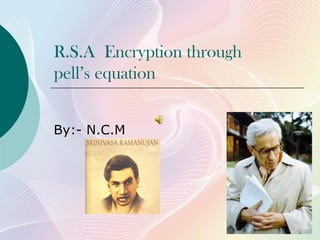Report
Share
Download to read offline

Recommended
More Related Content
What's hot
What's hot (18)
Lesson 17: Interminate forms and L'Hôpital's Rule (worksheet solutions)

Lesson 17: Interminate forms and L'Hôpital's Rule (worksheet solutions)
Similar to R.S.A Encryption
2018 MUMS Fall Course - Statistical Representation of Model Input (EDITED) - ...

2018 MUMS Fall Course - Statistical Representation of Model Input (EDITED) - ...The Statistical and Applied Mathematical Sciences Institute
Similar to R.S.A Encryption (20)
Simplified Runtime Analysis of Estimation of Distribution Algorithms

Simplified Runtime Analysis of Estimation of Distribution Algorithms
Simplified Runtime Analysis of Estimation of Distribution Algorithms

Simplified Runtime Analysis of Estimation of Distribution Algorithms
2018 MUMS Fall Course - Statistical Representation of Model Input (EDITED) - ...

2018 MUMS Fall Course - Statistical Representation of Model Input (EDITED) - ...
A Szemeredi-type theorem for subsets of the unit cube

A Szemeredi-type theorem for subsets of the unit cube
More from Chandramowliswaran NARAYANASWAMY
More from Chandramowliswaran NARAYANASWAMY (20)
R.S.A Encryption
- 1. R.S.A Encryption through pell’s equation By:- N.C.M
- 2. STEP 1 Select a secret ODD prime integer “R”
- 3. STEP 2 Consider the Diophantine Equation: Y2 – R X2 = 1 Let (Y0 , X0 ) be the least “positive” integral Solution of . Here X0,Y0 are kept secret. 1 1
- 4. STEP 3 Select two large ODD primes p,q DEFINE:- N: = pq 2
- 5. STEP 4 Define α:= [Y0+ φ(n)]2 – R [Xo + e]2; Where “e” can be chosen such that 1<e< φ(n) and G.C.D ( e, φ(n)) = 1 Since G.C.D (e, φ(n))=1, there is a unique “positive” integer “d” such that de≡1(Mod φ(n)) ASSUME Here φ(n) = Euler’s φ function 3 d3 ≠ 1(Modφ(n)) e3 ≠ 1(Modφ(n))
- 6. STEP 5 From (3), we have α = Y0 2 +[φ(n)]2 + 2Yoφ(n) −R[Xo 2+e2+2X0e] = Y0 2 −RXo 2 +[φ(n)]2 + 2Y0 φ(n)− Re2− 2X0eR α ≡1 − Re2 − 2X0eR (Mod φ(n)) α + Re2 + 2X0eR ≡ 1 (Mod φ(n)) Multiply by d3 on both sides, of the above congruence We get, αd3+ Rd + 2X0d2R ≡ d3 (Mod φ(n))
- 7. STEP 6 Define: S = αd3 + 2x0d2R + Rd so, S ≡ d3 (Mod φ(n))
- 8. Step 7 Represent the given message “m” in the interval (0, n-1)
- 9. Step 8 ASSUME G.C.D (m,n) =1
- 10. Step 9 Encryption :E ≡ mS (mod n) ≡ m +k∙φ(n) (mod n) ≡ m ∙[mφ(n)]k (mod n) So, E ≡ m (mod n) Public key : = S, n
- 11. Step 10 Decryption = E (mod n) = (m ) (mod n) = m (mod n) [d3e3 ≡1(mod φ(n)] =m (mod n)
- 12. Step 10 Contd.. d3e3 = 1 +k1∙φ(n) m = m∙[mφ(n)]k (Mod n) = m(Mod n) 1